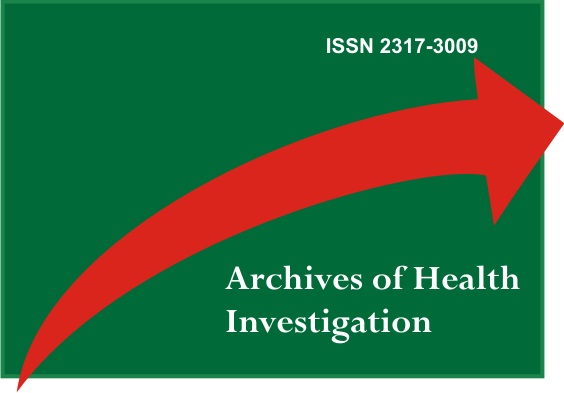Perfil das tenossinovites infecciosas em hospital terciário no Brasil
DOI:
https://doi.org/10.21270/archi.v10i4.5389Palavras-chave:
Tenossinovite, Infecção, BactériasResumo
A tenossinovite piogênica é uma infecção da bainha do tendão flexor do dedo que pode resultar em necrose e aderência do tendão, perda de movimento, deformidade e, em último caso, acarretar perda do membro se o tratamento não for instituído rápido e adequadamente. O objetivo desse estudo é descrever o perfil epidemiológico e bacteriológico dos pacientes com o diagnóstico de tenossinovite infecciosa em um hospital terciário. Os dados foram coletados dos prontuários dos pacientes atendidos na instituição no período de janeiro de 2019 a junho de 2020 com o diagnóstico confirmado de tenossinovite infecciosa, e que tenham sido submetidos a tratamento clínico e cirúrgico. Os resultados encontrados foram: a prevalência de pacientes do sexo masculino, com média de 42 anos de idade, contaminados após ferimentos perfurocortantes. A bactéria mais encontrada foi Staphylococcus aureus e os resultados mais favoráveis foram nos pacientes que iniciaram o tratamento em menos de 72 horas do início dos sintomas. A suspeita clínica e o reconhecimento precoce do agente etiológico se mostraram fundamentais para minimizar as consequências potencialmente devastadoras do atraso no tratamento desta doença.
Downloads
Referências
Osterman M, Draeger R, Stern P. Acute hand infections. J Hand Surg Am. 2014;39(8):1628-35; quiz 1635.
Franko OI, Abrams RA. Hand infections. Orthop Clin North Am. 2013;44(4):625-34.
Kanavel AB. The symptoms, signs, and diagnosis of tenosynovitis and fascial-space abscesses. In Infections of the Hand. 1st ed. Philadelphia, PA: Lea & Febiger; 1912:201-226.
Kanavel AB. Infections of the Hand: A Guide to the Surgical Treatment of Acute and Chronic Suppurative Processes in the Fingers, Hand and Forearm. 7. Philadelphia, PA: Lea & Febiger; 1939.
Draeger RW, Bynum DK Jr. Flexor tendon sheath infections of the hand. J Am Acad Orthop Surg. 2012;20(6):373-82.
Kennedy CD, Lauder AS, Pribaz JR, Kennedy SA. Differentiation Between Pyogenic Flexor Tenosynovitis and Other Finger Infections. Hand (N Y). 2017;12(6):585-90.
Prunières G, Igeta Y, Hidalgo Díaz JJ, Gouzou S, Facca S, Xavier F et al. Ultrasound for the diagnosis of pyogenic flexor tenosynovitis. Hand Surg Rehabil. 2018:S2468-1229(18)30061-6.
Houshian S, Seyedipour S, Wedderkopp N. Epidemiology of bacterial hand infections. Int J Infect Dis. 2006;10(4):315-19.
Patel DB, Emmanuel NB, Stevanovic MV, Matcuk GR Jr, Gottsegen CJ, Forrester DM et al. Hand infections: anatomy, types and spread of infection, imaging findings, and treatment options. Radiographics. 2014;34(7):1968-86.
Giladi AM, Malay S, Chung KC. A systematic review of the management of acute pyogenic flexor tenosynovitis. J Hand Surg Eur Vol. 2015;40(7):720-28.
Nikkhah D, Rodrigues J, Osman K, Dejager L. Pyogenic flexor tenosynovitis: one year's experience at a UK hand unit and a review of the current literature. Hand Surg. 2012;17(2):199-203.
Stern PJ, Staneck JL, McDonough JJ, Neale HW, Tyler G. Established hand infections: a controlled, prospective study. J Hand Surg Am. 1983;8(5 Pt 1):553-59.
Born TR, Wagner ER, Kakar S. Comparison of Open Drainage Versus Closed Catheter Irrigation for Treatment of Suppurative Flexor Tenosynovitis. Hand (N Y). 2017;12(6):579-84.
Bolton LE, Bainbridge C. Current opinions regarding the management of pyogenic flexor tenosynovitis: a survey of Pulvertaft Hand Trauma Symposium attendees. Infection. 2019;47(2):225-31.
Pang HN, Teoh LC, Yam AK, Lee JY, Puhaindran ME, Tan AB. Factors affecting the prognosis of pyogenic flexor tenosynovitis. J Bone Joint Surg Am. 2007;89(8):1742-48.
Henton J, Jain A. Cochrane corner: antibiotic prophylaxis for mammalian bites (intervention review). J Hand Surg Eur Vol. 2012;37(8):804-6.


